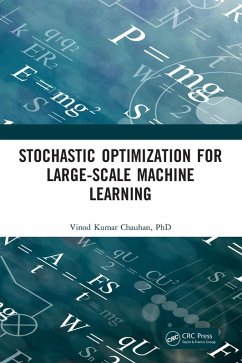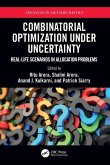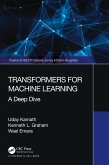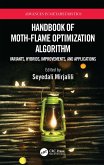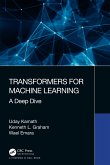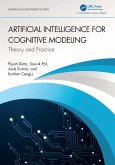Vinod Kumar Chauhan
Stochastic Optimization for Large-scale Machine Learning
Vinod Kumar Chauhan
Stochastic Optimization for Large-scale Machine Learning
- Gebundenes Buch
- Merkliste
- Auf die Merkliste
- Bewerten Bewerten
- Teilen
- Produkt teilen
- Produkterinnerung
- Produkterinnerung
Stochastic Optimization for Large-scale Machine Learning identifies different areas of improvement and recent research directions to tackle the challenge. Developed optimisation techniques are also explored to improve machine learning algorithms based on data access and on first and second order optimisation methods.
Andere Kunden interessierten sich auch für
![Combinatorial Optimization Under Uncertainty Combinatorial Optimization Under Uncertainty]() Combinatorial Optimization Under Uncertainty65,99 €
Combinatorial Optimization Under Uncertainty65,99 €![Transformers for Machine Learning Transformers for Machine Learning]() Uday KamathTransformers for Machine Learning53,99 €
Uday KamathTransformers for Machine Learning53,99 €![Handbook of Moth-Flame Optimization Algorithm Handbook of Moth-Flame Optimization Algorithm]() Handbook of Moth-Flame Optimization Algorithm105,99 €
Handbook of Moth-Flame Optimization Algorithm105,99 €![Transformers for Machine Learning Transformers for Machine Learning]() Uday KamathTransformers for Machine Learning111,99 €
Uday KamathTransformers for Machine Learning111,99 €![The Pragmatic Programmer for Machine Learning The Pragmatic Programmer for Machine Learning]() Marco Scutari (Istituto Dalle Molle)The Pragmatic Programmer for Machine Learning65,99 €
Marco Scutari (Istituto Dalle Molle)The Pragmatic Programmer for Machine Learning65,99 €![Artificial Intelligence for Cognitive Modeling Artificial Intelligence for Cognitive Modeling]() Pijush Dutta (GKCEM, Baruipur, India)Artificial Intelligence for Cognitive Modeling65,99 €
Pijush Dutta (GKCEM, Baruipur, India)Artificial Intelligence for Cognitive Modeling65,99 €![The Pragmatic Programmer for Machine Learning The Pragmatic Programmer for Machine Learning]() Marco Scutari (Istituto Dalle Molle)The Pragmatic Programmer for Machine Learning97,99 €
Marco Scutari (Istituto Dalle Molle)The Pragmatic Programmer for Machine Learning97,99 €-
-
-
Stochastic Optimization for Large-scale Machine Learning identifies different areas of improvement and recent research directions to tackle the challenge. Developed optimisation techniques are also explored to improve machine learning algorithms based on data access and on first and second order optimisation methods.
Produktdetails
- Produktdetails
- Verlag: Taylor & Francis Ltd
- Seitenzahl: 178
- Erscheinungstermin: 19. November 2021
- Englisch
- Abmessung: 260mm x 183mm x 14mm
- Gewicht: 532g
- ISBN-13: 9781032131757
- ISBN-10: 1032131756
- Artikelnr.: 62799480
- Herstellerkennzeichnung
- Libri GmbH
- Europaallee 1
- 36244 Bad Hersfeld
- gpsr@libri.de
- Verlag: Taylor & Francis Ltd
- Seitenzahl: 178
- Erscheinungstermin: 19. November 2021
- Englisch
- Abmessung: 260mm x 183mm x 14mm
- Gewicht: 532g
- ISBN-13: 9781032131757
- ISBN-10: 1032131756
- Artikelnr.: 62799480
- Herstellerkennzeichnung
- Libri GmbH
- Europaallee 1
- 36244 Bad Hersfeld
- gpsr@libri.de
Dr. Vinod Kumar Chauhan is a Research Associate in Industrial Machine Learning in the Institute for Manufacturing, Department of Engineering at University of Cambridge UK. He has a PhD in Machine Learning from Panjab University Chandigarh India. His research interests are in Machine Learning, Optimization and Network Science. He specializes in solving large-scale optimization problems in Machine Learning, handwriting recognition, flight delay propagation in airlines, robustness and nestedness in complex networks and supply chain design using mathematical programming, genetic algorithms and reinforcement learning.
List of Figures
List of Tables
Preface
Section I BACKGROUND
Introduction
1.1 LARGE-SCALE MACHINE LEARNING
1.2 OPTIMIZATION PROBLEMS
1.3 LINEAR CLASSIFICATION
1.3.1 Support Vector Machine (SVM)
1.3.2 Logistic Regression
1.3.3 First and Second Order Methods
1.3.3.1 First Order Methods
1.3.3.2 Second Order Methods
1.4 STOCHASTIC APPROXIMATION APPROACH
1.5 COORDINATE DESCENT APPROACH
1.6 DATASETS
1.7 ORGANIZATION OF BOOK
Optimisation Problem, Solvers, Challenges and Research Directions
2.1 INTRODUCTION
2.1.1 Contributions
2.2 LITERATURE
2.3 PROBLEM FORMULATIONS
2.3.1 Hard Margin SVM (1992)
2.3.2 Soft Margin SVM (1995)
2.3.3 One-versus-Rest (1998)
2.3.4 One-versus-One (1999)
2.3.5 Least Squares SVM (1999)
2.3.6 v-SVM (2000)
2.3.7 Smooth SVM (2001)
2.3.8 Proximal SVM (2001)
2.3.9 Crammer Singer SVM (2002)
2.3.10 Ev-SVM (2003)
2.3.11 Twin SVM (2007)
2.3.12 Capped lp-norm SVM (2017)
2.4 PROBLEM SOLVERS
2.4.1 Exact Line Search Method
2.4.2 Backtracking Line Search
2.4.3 Constant Step Size
2.4.4 Lipschitz & Strong Convexity Constants
2.4.5 Trust Region Method
2.4.6 Gradient Descent Method
2.4.7 Newton Method
2.4.8 Gauss-Newton Method
2.4.9 Levenberg-Marquardt Method
2.4.10 Quasi-Newton Method
2.4.11 Subgradient Method
2.4.12 Conjugate Gradient Method
2.4.13 Truncated Newton Method
2.4.14 Proximal Gradient Method
2.4.15 Recent Algorithms
2.5 COMPARATIVE STUDY
2.5.1 Results from Literature
2.5.2 Results from Experimental Study
2.5.2.1 Experimental Setup and Implementation Details
2.5.2.2 Results and Discussions
2.6 CURRENT CHALLENGES AND RESEARCH DIRECTIONS
2.6.1 Big Data Challenge
2.6.2 Areas of Improvement
2.6.2.1 Problem Formulations
2.6.2.2 Problem Solvers
2.6.2.3 Problem Solving Strategies/Approaches
2.6.2.4 Platforms/Frameworks
2.6.3 Research Directions
2.6.3.1 Stochastic Approximation Algorithms
2.6.3.2 Coordinate Descent Algorithms
2.6.3.3 Proximal Algorithms
2.6.3.4 Parallel/Distributed Algorithms
2.6.3.5 Hybrid Algorithms
2.7 CONCLUSION
Section II FIRST ORDER METHODS
Mini-batch and Block-coordinate Approach
3.1 INTRODUCTION
3.1.1 Motivation
3.1.2 Batch Block Optimization Framework (BBOF)
3.1.3 Brief Literature Review
3.1.4 Contributions
3.2 STOCHASTIC AVERAGE ADJUSTED GRADIENT (SAAG) METHODS
3.3 ANALYSIS
3.4 NUMERICAL EXPERIMENTS
3.4.1 Experimental setup
3.4.2 Convergence against epochs
3.4.3 Convergence against Time
3.5 CONCLUSION AND FUTURE SCOPE
Variance Reduction Methods
4.1 INTRODUCTION
4.1.1 Optimization Problem
4.1.2 Solution Techniques for Optimization Problem
4.1.3 Contributions
4.2 NOTATIONS AND RELATED WORK
4.2.1 Notations
4.2.2 Related Work
4.3 SAAG-I, II AND PROXIMAL EXTENSIONS
4.4 SAAG-III AND IV ALGORITHMS
4.5 ANALYSIS
4.6 EXPERIMENTAL RESULTS
4.6.1 Experimental Setup
4.6.2 Results with Smooth Problem
4.6.3 Results with non-smooth Problem
4.6.4 Mini-batch Block-coordinate versus mini-batch setting
4.6.5 Results with SVM
4.7 CONCLUSION
Learning and Data Access
5.1 INTRODUCTION
5.1.1 Optimization Problem
5.1.2 Literature Review
5.1.3 Contributions
5.2 SYSTEMATIC SAMPLING
5.2.1 Definitions
5.2.2 Learning using Systematic Sampling
5.3 ANALYSIS
5.4 EXPERIMENTS
5.4.1 Experimental Setup
5.4.2 Implementation Details
5.4.3 Results
5.5 CONCLUSION
Section III SECOND ORDER METHODS
Mini-batch Block-coordinate Newton Method
6.1 INTRODUCTION
6.1.1 Contributions
6.2 MBN
6.3 EXPERIMENTS
6.3.1 Experimental Setup
6.3.2 Comparative Study
6.4 CONCLUSION
Stochastic Trust Region Inexact Newton Method
7.1 INTRODUCTION
7.1.1 Optimization Problem
7.1.2 Solution Techniques
7.1.3 Contributions
7.2 LITERATURE REVIEW
7.3 TRUST REGION INEXACT NEWTON METHOD
7.3.1 Inexact Newton Method
7.3.2 Trust Region Inexact Newton Method
7.4 STRON
7.4.1 Complexity
7.4.2 Analysis
7.5 EXPERIMENTAL RESULTS
7.5.1 Experimental Setup
7.5.2 Comparative Study
7.5.3 Results with SVM
7.6 EXTENSIONS
7.6.1 PCG Subproblem Solver 1
7.6.2 Stochastic Variance Reduced Trust Region Inexact Newton Method
7.7 CONCLUSION
Section IV CONCLUSION
Conclusion and Future Scope
8.1 FUTURE SCOPE 142
Bibliography
Index
List of Tables
Preface
Section I BACKGROUND
Introduction
1.1 LARGE-SCALE MACHINE LEARNING
1.2 OPTIMIZATION PROBLEMS
1.3 LINEAR CLASSIFICATION
1.3.1 Support Vector Machine (SVM)
1.3.2 Logistic Regression
1.3.3 First and Second Order Methods
1.3.3.1 First Order Methods
1.3.3.2 Second Order Methods
1.4 STOCHASTIC APPROXIMATION APPROACH
1.5 COORDINATE DESCENT APPROACH
1.6 DATASETS
1.7 ORGANIZATION OF BOOK
Optimisation Problem, Solvers, Challenges and Research Directions
2.1 INTRODUCTION
2.1.1 Contributions
2.2 LITERATURE
2.3 PROBLEM FORMULATIONS
2.3.1 Hard Margin SVM (1992)
2.3.2 Soft Margin SVM (1995)
2.3.3 One-versus-Rest (1998)
2.3.4 One-versus-One (1999)
2.3.5 Least Squares SVM (1999)
2.3.6 v-SVM (2000)
2.3.7 Smooth SVM (2001)
2.3.8 Proximal SVM (2001)
2.3.9 Crammer Singer SVM (2002)
2.3.10 Ev-SVM (2003)
2.3.11 Twin SVM (2007)
2.3.12 Capped lp-norm SVM (2017)
2.4 PROBLEM SOLVERS
2.4.1 Exact Line Search Method
2.4.2 Backtracking Line Search
2.4.3 Constant Step Size
2.4.4 Lipschitz & Strong Convexity Constants
2.4.5 Trust Region Method
2.4.6 Gradient Descent Method
2.4.7 Newton Method
2.4.8 Gauss-Newton Method
2.4.9 Levenberg-Marquardt Method
2.4.10 Quasi-Newton Method
2.4.11 Subgradient Method
2.4.12 Conjugate Gradient Method
2.4.13 Truncated Newton Method
2.4.14 Proximal Gradient Method
2.4.15 Recent Algorithms
2.5 COMPARATIVE STUDY
2.5.1 Results from Literature
2.5.2 Results from Experimental Study
2.5.2.1 Experimental Setup and Implementation Details
2.5.2.2 Results and Discussions
2.6 CURRENT CHALLENGES AND RESEARCH DIRECTIONS
2.6.1 Big Data Challenge
2.6.2 Areas of Improvement
2.6.2.1 Problem Formulations
2.6.2.2 Problem Solvers
2.6.2.3 Problem Solving Strategies/Approaches
2.6.2.4 Platforms/Frameworks
2.6.3 Research Directions
2.6.3.1 Stochastic Approximation Algorithms
2.6.3.2 Coordinate Descent Algorithms
2.6.3.3 Proximal Algorithms
2.6.3.4 Parallel/Distributed Algorithms
2.6.3.5 Hybrid Algorithms
2.7 CONCLUSION
Section II FIRST ORDER METHODS
Mini-batch and Block-coordinate Approach
3.1 INTRODUCTION
3.1.1 Motivation
3.1.2 Batch Block Optimization Framework (BBOF)
3.1.3 Brief Literature Review
3.1.4 Contributions
3.2 STOCHASTIC AVERAGE ADJUSTED GRADIENT (SAAG) METHODS
3.3 ANALYSIS
3.4 NUMERICAL EXPERIMENTS
3.4.1 Experimental setup
3.4.2 Convergence against epochs
3.4.3 Convergence against Time
3.5 CONCLUSION AND FUTURE SCOPE
Variance Reduction Methods
4.1 INTRODUCTION
4.1.1 Optimization Problem
4.1.2 Solution Techniques for Optimization Problem
4.1.3 Contributions
4.2 NOTATIONS AND RELATED WORK
4.2.1 Notations
4.2.2 Related Work
4.3 SAAG-I, II AND PROXIMAL EXTENSIONS
4.4 SAAG-III AND IV ALGORITHMS
4.5 ANALYSIS
4.6 EXPERIMENTAL RESULTS
4.6.1 Experimental Setup
4.6.2 Results with Smooth Problem
4.6.3 Results with non-smooth Problem
4.6.4 Mini-batch Block-coordinate versus mini-batch setting
4.6.5 Results with SVM
4.7 CONCLUSION
Learning and Data Access
5.1 INTRODUCTION
5.1.1 Optimization Problem
5.1.2 Literature Review
5.1.3 Contributions
5.2 SYSTEMATIC SAMPLING
5.2.1 Definitions
5.2.2 Learning using Systematic Sampling
5.3 ANALYSIS
5.4 EXPERIMENTS
5.4.1 Experimental Setup
5.4.2 Implementation Details
5.4.3 Results
5.5 CONCLUSION
Section III SECOND ORDER METHODS
Mini-batch Block-coordinate Newton Method
6.1 INTRODUCTION
6.1.1 Contributions
6.2 MBN
6.3 EXPERIMENTS
6.3.1 Experimental Setup
6.3.2 Comparative Study
6.4 CONCLUSION
Stochastic Trust Region Inexact Newton Method
7.1 INTRODUCTION
7.1.1 Optimization Problem
7.1.2 Solution Techniques
7.1.3 Contributions
7.2 LITERATURE REVIEW
7.3 TRUST REGION INEXACT NEWTON METHOD
7.3.1 Inexact Newton Method
7.3.2 Trust Region Inexact Newton Method
7.4 STRON
7.4.1 Complexity
7.4.2 Analysis
7.5 EXPERIMENTAL RESULTS
7.5.1 Experimental Setup
7.5.2 Comparative Study
7.5.3 Results with SVM
7.6 EXTENSIONS
7.6.1 PCG Subproblem Solver 1
7.6.2 Stochastic Variance Reduced Trust Region Inexact Newton Method
7.7 CONCLUSION
Section IV CONCLUSION
Conclusion and Future Scope
8.1 FUTURE SCOPE 142
Bibliography
Index
List of Figures
List of Tables
Preface
Section I BACKGROUND
Introduction
1.1 LARGE-SCALE MACHINE LEARNING
1.2 OPTIMIZATION PROBLEMS
1.3 LINEAR CLASSIFICATION
1.3.1 Support Vector Machine (SVM)
1.3.2 Logistic Regression
1.3.3 First and Second Order Methods
1.3.3.1 First Order Methods
1.3.3.2 Second Order Methods
1.4 STOCHASTIC APPROXIMATION APPROACH
1.5 COORDINATE DESCENT APPROACH
1.6 DATASETS
1.7 ORGANIZATION OF BOOK
Optimisation Problem, Solvers, Challenges and Research Directions
2.1 INTRODUCTION
2.1.1 Contributions
2.2 LITERATURE
2.3 PROBLEM FORMULATIONS
2.3.1 Hard Margin SVM (1992)
2.3.2 Soft Margin SVM (1995)
2.3.3 One-versus-Rest (1998)
2.3.4 One-versus-One (1999)
2.3.5 Least Squares SVM (1999)
2.3.6 v-SVM (2000)
2.3.7 Smooth SVM (2001)
2.3.8 Proximal SVM (2001)
2.3.9 Crammer Singer SVM (2002)
2.3.10 Ev-SVM (2003)
2.3.11 Twin SVM (2007)
2.3.12 Capped lp-norm SVM (2017)
2.4 PROBLEM SOLVERS
2.4.1 Exact Line Search Method
2.4.2 Backtracking Line Search
2.4.3 Constant Step Size
2.4.4 Lipschitz & Strong Convexity Constants
2.4.5 Trust Region Method
2.4.6 Gradient Descent Method
2.4.7 Newton Method
2.4.8 Gauss-Newton Method
2.4.9 Levenberg-Marquardt Method
2.4.10 Quasi-Newton Method
2.4.11 Subgradient Method
2.4.12 Conjugate Gradient Method
2.4.13 Truncated Newton Method
2.4.14 Proximal Gradient Method
2.4.15 Recent Algorithms
2.5 COMPARATIVE STUDY
2.5.1 Results from Literature
2.5.2 Results from Experimental Study
2.5.2.1 Experimental Setup and Implementation Details
2.5.2.2 Results and Discussions
2.6 CURRENT CHALLENGES AND RESEARCH DIRECTIONS
2.6.1 Big Data Challenge
2.6.2 Areas of Improvement
2.6.2.1 Problem Formulations
2.6.2.2 Problem Solvers
2.6.2.3 Problem Solving Strategies/Approaches
2.6.2.4 Platforms/Frameworks
2.6.3 Research Directions
2.6.3.1 Stochastic Approximation Algorithms
2.6.3.2 Coordinate Descent Algorithms
2.6.3.3 Proximal Algorithms
2.6.3.4 Parallel/Distributed Algorithms
2.6.3.5 Hybrid Algorithms
2.7 CONCLUSION
Section II FIRST ORDER METHODS
Mini-batch and Block-coordinate Approach
3.1 INTRODUCTION
3.1.1 Motivation
3.1.2 Batch Block Optimization Framework (BBOF)
3.1.3 Brief Literature Review
3.1.4 Contributions
3.2 STOCHASTIC AVERAGE ADJUSTED GRADIENT (SAAG) METHODS
3.3 ANALYSIS
3.4 NUMERICAL EXPERIMENTS
3.4.1 Experimental setup
3.4.2 Convergence against epochs
3.4.3 Convergence against Time
3.5 CONCLUSION AND FUTURE SCOPE
Variance Reduction Methods
4.1 INTRODUCTION
4.1.1 Optimization Problem
4.1.2 Solution Techniques for Optimization Problem
4.1.3 Contributions
4.2 NOTATIONS AND RELATED WORK
4.2.1 Notations
4.2.2 Related Work
4.3 SAAG-I, II AND PROXIMAL EXTENSIONS
4.4 SAAG-III AND IV ALGORITHMS
4.5 ANALYSIS
4.6 EXPERIMENTAL RESULTS
4.6.1 Experimental Setup
4.6.2 Results with Smooth Problem
4.6.3 Results with non-smooth Problem
4.6.4 Mini-batch Block-coordinate versus mini-batch setting
4.6.5 Results with SVM
4.7 CONCLUSION
Learning and Data Access
5.1 INTRODUCTION
5.1.1 Optimization Problem
5.1.2 Literature Review
5.1.3 Contributions
5.2 SYSTEMATIC SAMPLING
5.2.1 Definitions
5.2.2 Learning using Systematic Sampling
5.3 ANALYSIS
5.4 EXPERIMENTS
5.4.1 Experimental Setup
5.4.2 Implementation Details
5.4.3 Results
5.5 CONCLUSION
Section III SECOND ORDER METHODS
Mini-batch Block-coordinate Newton Method
6.1 INTRODUCTION
6.1.1 Contributions
6.2 MBN
6.3 EXPERIMENTS
6.3.1 Experimental Setup
6.3.2 Comparative Study
6.4 CONCLUSION
Stochastic Trust Region Inexact Newton Method
7.1 INTRODUCTION
7.1.1 Optimization Problem
7.1.2 Solution Techniques
7.1.3 Contributions
7.2 LITERATURE REVIEW
7.3 TRUST REGION INEXACT NEWTON METHOD
7.3.1 Inexact Newton Method
7.3.2 Trust Region Inexact Newton Method
7.4 STRON
7.4.1 Complexity
7.4.2 Analysis
7.5 EXPERIMENTAL RESULTS
7.5.1 Experimental Setup
7.5.2 Comparative Study
7.5.3 Results with SVM
7.6 EXTENSIONS
7.6.1 PCG Subproblem Solver 1
7.6.2 Stochastic Variance Reduced Trust Region Inexact Newton Method
7.7 CONCLUSION
Section IV CONCLUSION
Conclusion and Future Scope
8.1 FUTURE SCOPE 142
Bibliography
Index
List of Tables
Preface
Section I BACKGROUND
Introduction
1.1 LARGE-SCALE MACHINE LEARNING
1.2 OPTIMIZATION PROBLEMS
1.3 LINEAR CLASSIFICATION
1.3.1 Support Vector Machine (SVM)
1.3.2 Logistic Regression
1.3.3 First and Second Order Methods
1.3.3.1 First Order Methods
1.3.3.2 Second Order Methods
1.4 STOCHASTIC APPROXIMATION APPROACH
1.5 COORDINATE DESCENT APPROACH
1.6 DATASETS
1.7 ORGANIZATION OF BOOK
Optimisation Problem, Solvers, Challenges and Research Directions
2.1 INTRODUCTION
2.1.1 Contributions
2.2 LITERATURE
2.3 PROBLEM FORMULATIONS
2.3.1 Hard Margin SVM (1992)
2.3.2 Soft Margin SVM (1995)
2.3.3 One-versus-Rest (1998)
2.3.4 One-versus-One (1999)
2.3.5 Least Squares SVM (1999)
2.3.6 v-SVM (2000)
2.3.7 Smooth SVM (2001)
2.3.8 Proximal SVM (2001)
2.3.9 Crammer Singer SVM (2002)
2.3.10 Ev-SVM (2003)
2.3.11 Twin SVM (2007)
2.3.12 Capped lp-norm SVM (2017)
2.4 PROBLEM SOLVERS
2.4.1 Exact Line Search Method
2.4.2 Backtracking Line Search
2.4.3 Constant Step Size
2.4.4 Lipschitz & Strong Convexity Constants
2.4.5 Trust Region Method
2.4.6 Gradient Descent Method
2.4.7 Newton Method
2.4.8 Gauss-Newton Method
2.4.9 Levenberg-Marquardt Method
2.4.10 Quasi-Newton Method
2.4.11 Subgradient Method
2.4.12 Conjugate Gradient Method
2.4.13 Truncated Newton Method
2.4.14 Proximal Gradient Method
2.4.15 Recent Algorithms
2.5 COMPARATIVE STUDY
2.5.1 Results from Literature
2.5.2 Results from Experimental Study
2.5.2.1 Experimental Setup and Implementation Details
2.5.2.2 Results and Discussions
2.6 CURRENT CHALLENGES AND RESEARCH DIRECTIONS
2.6.1 Big Data Challenge
2.6.2 Areas of Improvement
2.6.2.1 Problem Formulations
2.6.2.2 Problem Solvers
2.6.2.3 Problem Solving Strategies/Approaches
2.6.2.4 Platforms/Frameworks
2.6.3 Research Directions
2.6.3.1 Stochastic Approximation Algorithms
2.6.3.2 Coordinate Descent Algorithms
2.6.3.3 Proximal Algorithms
2.6.3.4 Parallel/Distributed Algorithms
2.6.3.5 Hybrid Algorithms
2.7 CONCLUSION
Section II FIRST ORDER METHODS
Mini-batch and Block-coordinate Approach
3.1 INTRODUCTION
3.1.1 Motivation
3.1.2 Batch Block Optimization Framework (BBOF)
3.1.3 Brief Literature Review
3.1.4 Contributions
3.2 STOCHASTIC AVERAGE ADJUSTED GRADIENT (SAAG) METHODS
3.3 ANALYSIS
3.4 NUMERICAL EXPERIMENTS
3.4.1 Experimental setup
3.4.2 Convergence against epochs
3.4.3 Convergence against Time
3.5 CONCLUSION AND FUTURE SCOPE
Variance Reduction Methods
4.1 INTRODUCTION
4.1.1 Optimization Problem
4.1.2 Solution Techniques for Optimization Problem
4.1.3 Contributions
4.2 NOTATIONS AND RELATED WORK
4.2.1 Notations
4.2.2 Related Work
4.3 SAAG-I, II AND PROXIMAL EXTENSIONS
4.4 SAAG-III AND IV ALGORITHMS
4.5 ANALYSIS
4.6 EXPERIMENTAL RESULTS
4.6.1 Experimental Setup
4.6.2 Results with Smooth Problem
4.6.3 Results with non-smooth Problem
4.6.4 Mini-batch Block-coordinate versus mini-batch setting
4.6.5 Results with SVM
4.7 CONCLUSION
Learning and Data Access
5.1 INTRODUCTION
5.1.1 Optimization Problem
5.1.2 Literature Review
5.1.3 Contributions
5.2 SYSTEMATIC SAMPLING
5.2.1 Definitions
5.2.2 Learning using Systematic Sampling
5.3 ANALYSIS
5.4 EXPERIMENTS
5.4.1 Experimental Setup
5.4.2 Implementation Details
5.4.3 Results
5.5 CONCLUSION
Section III SECOND ORDER METHODS
Mini-batch Block-coordinate Newton Method
6.1 INTRODUCTION
6.1.1 Contributions
6.2 MBN
6.3 EXPERIMENTS
6.3.1 Experimental Setup
6.3.2 Comparative Study
6.4 CONCLUSION
Stochastic Trust Region Inexact Newton Method
7.1 INTRODUCTION
7.1.1 Optimization Problem
7.1.2 Solution Techniques
7.1.3 Contributions
7.2 LITERATURE REVIEW
7.3 TRUST REGION INEXACT NEWTON METHOD
7.3.1 Inexact Newton Method
7.3.2 Trust Region Inexact Newton Method
7.4 STRON
7.4.1 Complexity
7.4.2 Analysis
7.5 EXPERIMENTAL RESULTS
7.5.1 Experimental Setup
7.5.2 Comparative Study
7.5.3 Results with SVM
7.6 EXTENSIONS
7.6.1 PCG Subproblem Solver 1
7.6.2 Stochastic Variance Reduced Trust Region Inexact Newton Method
7.7 CONCLUSION
Section IV CONCLUSION
Conclusion and Future Scope
8.1 FUTURE SCOPE 142
Bibliography
Index

